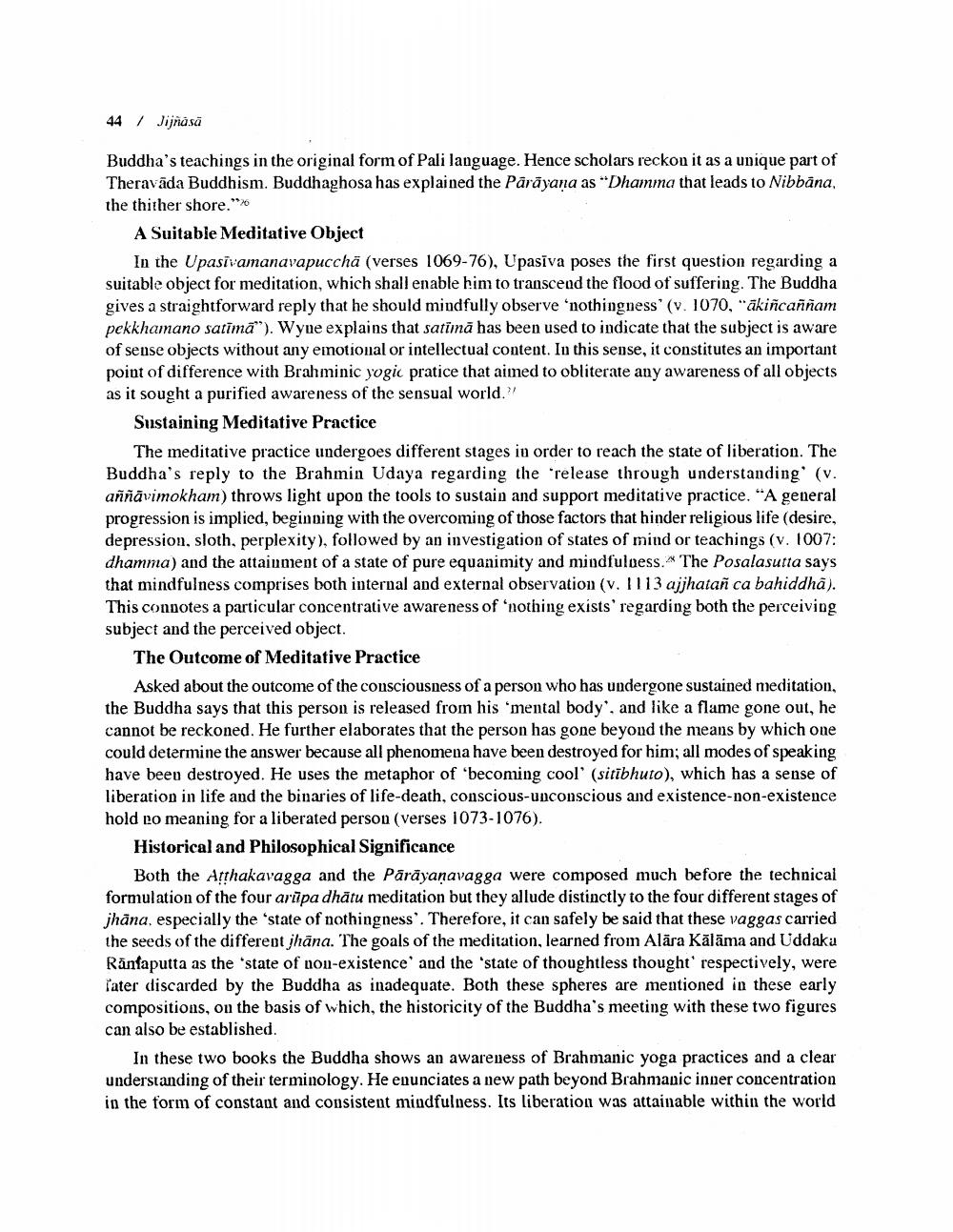________________
44
/ Jijāsā
Buddha's teachings in the original form of Pali language. Hence scholars reckon it as a unique part of Theravāda Buddhism. Buddhaghosa has explained the Pārāyana as Dhamma that leads to Nibbāna, the thither shore."
A Suitable Meditative Object
In the Upasivamanavapucchā (verses 1069-76), Upasīva poses the first question regarding a suitable object for meditation, which shall enable him to transcend the flood of suffering. The Buddha gives a straightforward reply that he should mindfully observe 'nothingness' (v. 1070, "ākiñcaññam pekkhamano satima"). Wyne explains that satimā has been used to indicate that the subject is aware of sense objects without any emotional or intellectual content. In this sense, it constitutes an important point of difference with Brahminic yogic pratice that aimed to obliterate any awareness of all objects as it sought a purified awareness of the sensual world.
Sustaining Meditative Practice
The meditative practice undergoes different stages in order to reach the state of liberation. The Buddha's reply to the Brahmin Udaya regarding the release through understanding (v. aññāvimokham) throws light upon the tools to sustain and support meditative practice. "A general progression is implied, beginning with the overcoming of those factors that hinder religious life (desire, depression, sloth, perplexity), followed by an investigation of states of mind or teachings (v. 1007: dhamma) and the attainment of a state of pure equanimity and mindfulness. The Posalasutta says that mindfulness comprises both internal and external observation (v. 1113 ajjhatañ ca bahiddhā). This connotes a particular concentrative awareness of 'nothing exists' regarding both the perceiving subject and the perceived object.
The Outcome of Meditative Practice
Asked about the outcome of the consciousness of a person who has undergone sustained meditation, the Buddha says that this person is released from his 'mental body, and like a flame gone out, he cannot be reckoned. He further elaborates that the person has gone beyond the means by which one could determine the answer because all phenomena have been destroyed for him; all modes of speaking have been destroyed. He uses the metaphor of becoming cool' (sitibhuto), which has a sense of liberation in life and the binaries of life-death, conscious-unconscious and existence-non-existence hold no meaning for a liberated person (verses 1073-1076).
Historical and Philosophical Significance
Both the Atthakavagga and the Pārāyaṇavagga were composed much before the technical formulation of the four artīpa dhātu meditation but they allude distinctly to the four different stages of jhāna, especially the state of nothingness'. Therefore, it can safely be said that these vaggas carried the seeds of the different jhāna. The goals of the meditation, learned from Alāra Kālāma and Uddaka Rántaputta as the state of non-existence and the state of thoughtless thought respectively, were Iater discarded by the Buddha as inadequate. Both these spheres are mentioned in these early compositions, on the basis of which, the historicity of the Buddha's meeting with these two figures can also be established.
In these two books the Buddha shows an awareness of Brahmanic yoga practices and a clear understanding of their terminology. He enunciates a new path beyond Brahmanic inner concentration in the form of constant and consistent mindfulness. Its liberation was attainable within the world




